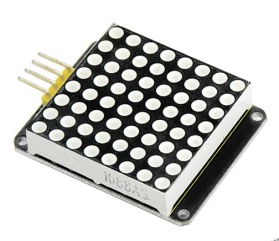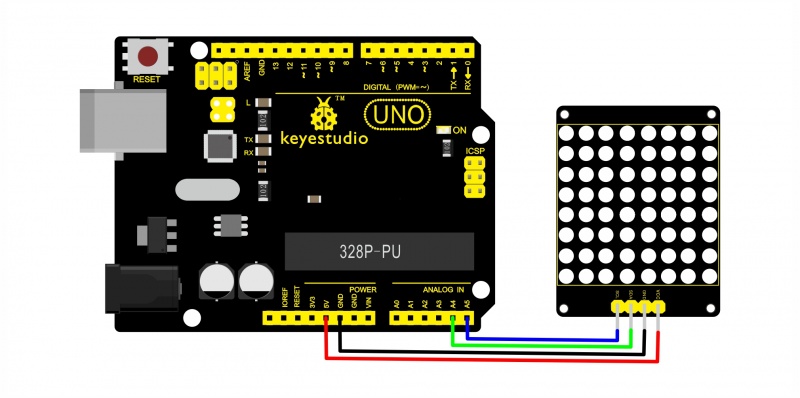Ks0064 keyestudio I2C 8x8 LED Matrix HT16K33: Difference between revisions
Keyestudio (talk | contribs) |
Keyestudio (talk | contribs) No edit summary |
||
| Line 1: | Line 1: | ||
[[image: | [[image:Ks0064-图片1.png|thumb|600px|right|Keyestudio PIR Motion Sensor 3PCS]] | ||
| Line 9: | Line 9: | ||
A fun way to make a small display is to use an 8x8 matrix or a 4-digit 7-segment display. Matrices like these are 'multiplexed' - to control 64 LEDs you need 16 pins. That's a lot of pins, and there are driver chips like the MAX7219 that can control a matrix for you, but there's a lot of wiring to set up and they take up a ton of space. After all, wouldn't it be awesome if you could control a matrix without tons of wiring? That's where these lovely LED matrix backpacks come in. <br> | A fun way to make a small display is to use an 8x8 matrix or a 4-digit 7-segment display. Matrices like these are 'multiplexed' - to control 64 LEDs you need 16 pins. That's a lot of pins, and there are driver chips like the MAX7219 that can control a matrix for you, but there's a lot of wiring to set up and they take up a ton of space. After all, wouldn't it be awesome if you could control a matrix without tons of wiring? That's where these lovely LED matrix backpacks come in. <br> | ||
The matrices use the constant-current drivers for ultra-bright, consistent color, 1/16 step display dimming, all via a simple I2C interface. These 1.2" matrix backpacks come with three address-selection jumpers so you can connect up to eight 1.2" 8x8's together (or a combination, such as four 1.2" 8x8's and four 7-segments, etc) on a single I2C bus. | The matrices use the constant-current drivers for ultra-bright, consistent color, 1/16 step display dimming, all via a simple I2C interface. These 1.2" matrix backpacks come with three address-selection jumpers so you can connect up to eight 1.2" 8x8's together (or a combination, such as four 1.2" 8x8's and four 7-segments, etc) on a single I2C bus. | ||
<br>[[Image:KS0336 (3)--.jpg|800px|frameless]]<br> | |||
Revision as of 17:35, 27 July 2018
Introduction
A fun way to make a small display is to use an 8x8 matrix or a 4-digit 7-segment display. Matrices like these are 'multiplexed' - to control 64 LEDs you need 16 pins. That's a lot of pins, and there are driver chips like the MAX7219 that can control a matrix for you, but there's a lot of wiring to set up and they take up a ton of space. After all, wouldn't it be awesome if you could control a matrix without tons of wiring? That's where these lovely LED matrix backpacks come in.
The matrices use the constant-current drivers for ultra-bright, consistent color, 1/16 step display dimming, all via a simple I2C interface. These 1.2" matrix backpacks come with three address-selection jumpers so you can connect up to eight 1.2" 8x8's together (or a combination, such as four 1.2" 8x8's and four 7-segments, etc) on a single I2C bus.
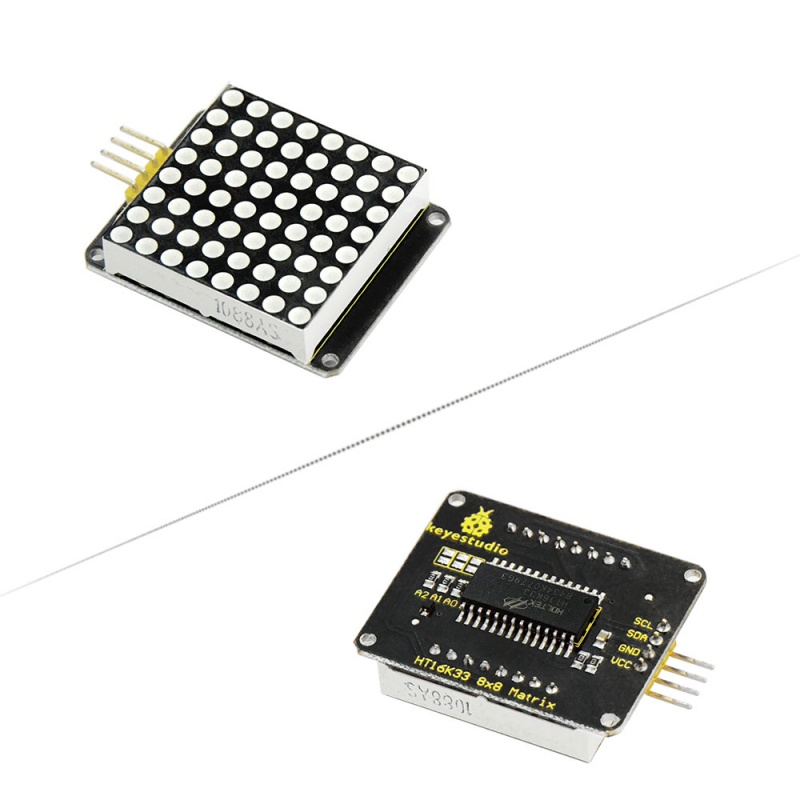
Features
- 8 rows and 8 cols LED matrix
- Driven by HT16K33 chip
- Access to I2C communication pins
- Occupy less IO ports of microcontrollers
- Easy connection and available for more experiment extensions
Parameters
- Input voltage: 5V
- Rated input frequency: 400KHZ
- Input power: 2.5W
- Input current: 500mA
Pinout
Wire it Up
Connect the SCL pin to Analog A5, SDA pin to Analog A4 port; Connect VCC pin to 5V port, GND pin to GND.
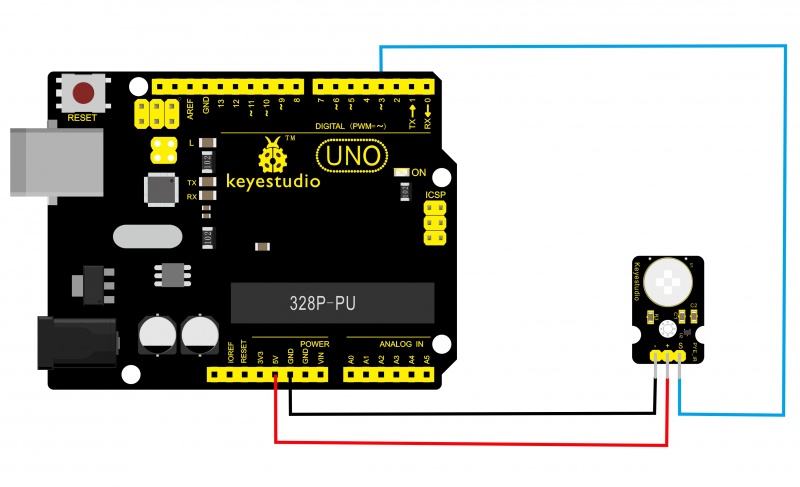
Sample Code
Below is an example code, you can upload it to Arduino IDE.
#include <Wire.h>
#include "Adafruit_LEDBackpack.h"
#include "Adafruit_GFX.h"
#ifndef _BV
#define _BV(bit) (1<<(bit))
#endif
Adafruit_LEDBackpack matrix = Adafruit_LEDBackpack();
uint8_t counter = 0;
void setup() {
Serial.begin(9600);
Serial.println("HT16K33 test");
matrix.begin(0x70); // pass in the address
}
void loop() {
// paint one LED per row. The HT16K33 internal memory looks like
// a 8x16 bit matrix (8 rows, 16 columns)
for (uint8_t i=0; i<8; i++) {
// draw a diagonal row of pixels
matrix.displaybuffer[i] = _BV((counter+i) % 16) | _BV((counter+i+8) % 16) ;
}
// write the changes we just made to the display
matrix.writeDisplay();
delay(100);
counter++;
if (counter >= 16) counter = 0;
}
Note: before upload the code, you should place the library inside Arduino libraries. Or else fail to compile it.
You can download the code libraries from the link below:
https://drive.google.com/open?id=1FUTIwsfGdxTXXgYDGxI7U2VoP0g3G-2L
Example Result
Done wiring and powered up, upload well the code to UNO board, you will see the dot matrix display the image shown below.
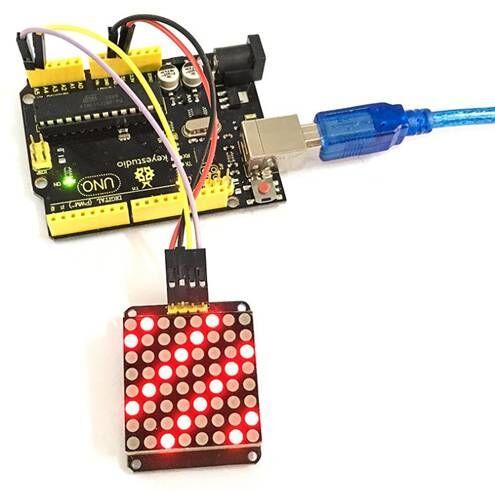
Resources
Buy From
- Official Website: http://www.keyestudio.com/ks0064.html
